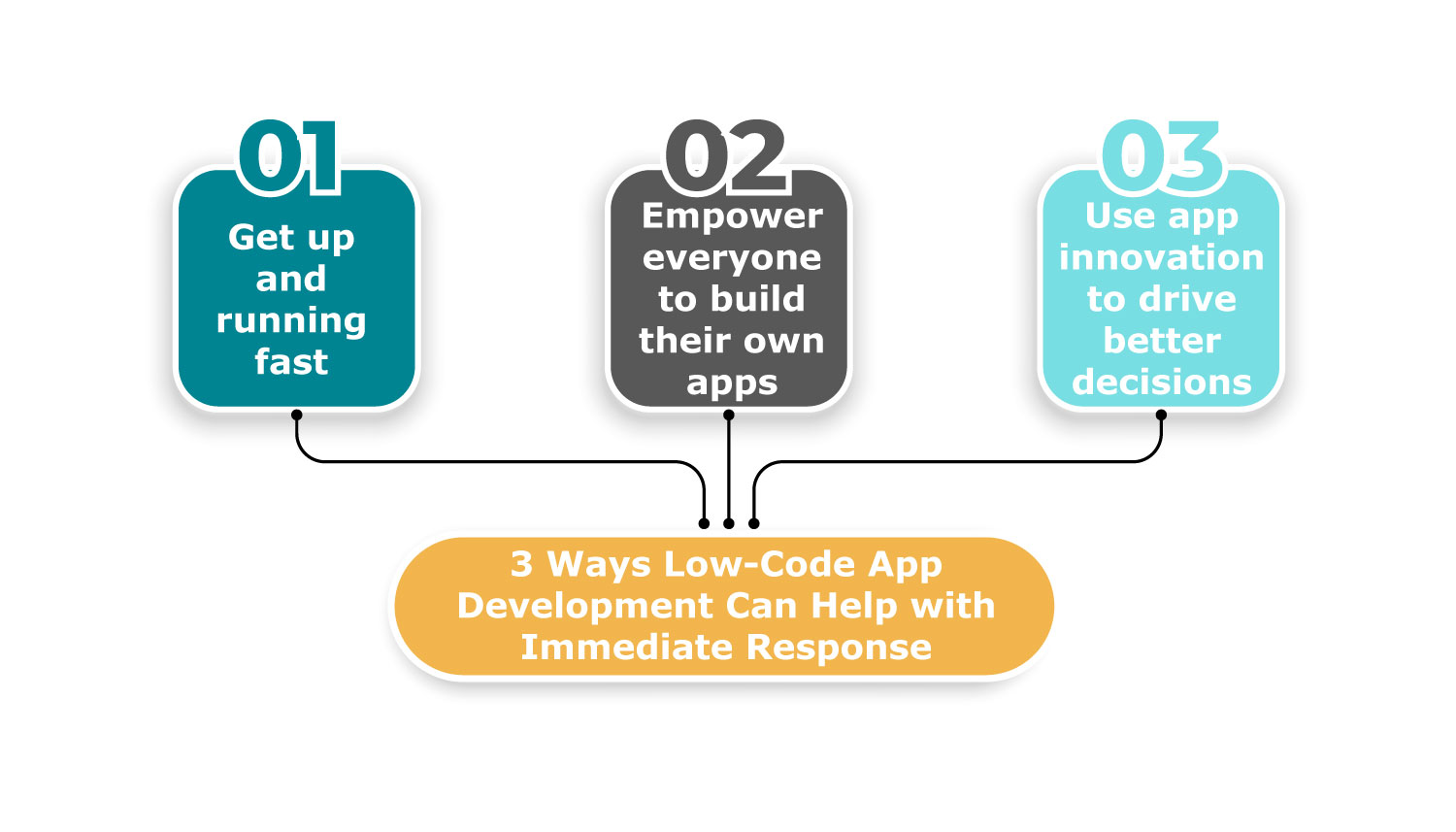3 Ways Low-Code App Development Can Help with Immediate Response
Low-code app development is a new and more efficient approach to building professional web and mobile applications. Instead of creating thousands of lines of code by hand, low-code development typically involves a highly visual user experience with prebuilt templates and drag-and-drop functionality.
This enables people with little to no programming experience, called citizen developers in the Microsoft world, to build their own apps, while making it easier for professional developers to accelerate foundational app development. Low-code app development increases productivity, reduces time and cost to build applications (including web and mobile) and powers innovation by making it easier for any great idea to become a useful app.
Low-code app development is not meant to replace traditional app development. Rather, it brings new tools to the table that empower citizen developers to build apps while giving professional developers a simple way to accelerate app development. This liberates highly skilled talent to focus on more strategic, high-value work.
Whether using pre-built templates or creating custom apps, low code development allows you to deliver apps in hours or days. And when companies need to respond in crisis situations, it’s even more important to be able to quickly build apps that solve emerging problems and give leadership insights into fast-changing, dynamic situations so they can take decisive action.
Because it doesn’t require coding experience, organisations can empower citizen developers—those closest to business problems—to build custom apps to meet their unique needs in an environment that is secure and compliant. By moving app development beyond the confines of the IT department, organisations can alleviate the demands on IT, allowing professional developers to focus on more complex, strategic initiatives.
Low-code techniques are changing the app development landscape, bringing agility and speed to a process long encumbered by time-consuming, expensive development cycles. When conditions are challenging, low-code development is well-positioned to help businesses in three specific ways.
- Get up and running fast
When you need to mobilise your business for an immediate response, you must be able to quickly deploy the right solutions. Imagine a restaurant group pivoting to provide free meals for families in need. Workers may need to track food donations, match available supplies to recipes, and organise and communicate with volunteers. None of these processes were in place before, but now every day without a tool that helps workers be more efficient means reaching fewer people in need and possibly unused food donations.
The low-code approach accelerates foundational app development and testing cycles so there’s more time to focus on customising, extending, and deploying solutions for individual scenarios, such as budget tracking, onboarding, asset checkout, or inventory management.
With Microsoft Power Apps, it’s also easy to connect your apps to other platforms and services. A restaurant may want to integrate an automatic post to Twitter every time a food donation is received and logged in inventory, helping elevate the visibility of their mission in social media. Power Apps offers more than 350 built-in connectors to your existing on-premises solutions, from Adobe to Zendesk.
- Empower everyone to build their own apps
Not long ago, a non-technical person wouldn’t dream of creating a website. But now with simple drag-and-drop website-building platforms, it takes much less skill. Low-code application development platforms bring these same benefits to creating software, enabling everyone to build apps and workflows that solve challenges.
With Power Apps, citizen developers are able to solve very specific business process problems on their own while professional developers are free to focus on custom solutions that require their advanced skills, as well as other high-value tasks.
No coding experience required
People who work day-to-day in knowledge-specific or specialised roles are often the first to recognise an inefficient process or identify a simpler solution to a problem. These insights can be lost in a complex coding environment, which excludes non-technical people. Low-code tools give those closest to the business challenge the resources to create custom solutions themselves. It also encourages collaboration across your organisation, while still giving IT control over data and management.
- Use app innovation to drive better decisions
The strongest decisions are those made with all available information. In a crisis situation, it can be hard for leadership to get visibility into the data they need to make a sound decision. Disruptions in normal business practices can make some data simply unavailable or harder to uncover. For example, imagine a community bank wants to provide emergency funding for small businesses in the quickest way possible. The amount of funds available to the community bank is dependent on the size of their small business clients, based on a number of employees. Small businesses with more employees will get more funding. But this data point was never collected from the account holders. Until they can collect this data, leadership at the community bank doesn’t know how much funding to request.
With low-code app development, the community bank can quickly build an app for small businesses to use when applying for emergency funding. They can capture the data points that are required to support more informed decision-making.

Know more
To effectively lead a company through a crisis, leadership must have visibility into the variables that are driving it. With Power Apps, its fully managed data platform significantly reduces the time and effort to build web and mobile applications while increasing overall data visibility and usability.
Authored by Microsoft
Why not contact us and speak to our experts to help you get started with Power Apps?
